Abstract
1. Prostanoid receptors present on the pregnant human myometrium in vitro have been characterized according to the receptor classification proposed by Coleman et al. (1984) using natural prostanoids and synthetic, selective analogues and antagonists where available. 2. Prostaglandin E2 (PGE2) produced a biphasic effect consisting of an initial excitation followed by a dose-related inhibition. The EP2/EP3-receptor agonists, rioprostil and misoprostol, produced similar effects to PGE2, however, the excitatory event of the misoprostol response was related to dose. The EP1/EP3-receptor agonist, sulprostone, evoked a purely excitatory response which was unaffected by AH6809. The selective EP2-receptor agonist butaprost produced a long-lasting dose-dependent inhibition of activity. The results from these prostanoids indicated that inhibitory EP2- and excitatory EP3-receptors are present on myometrium from pregnant donors at term. 3. PGF2 alpha and the synthetic FP-receptor agonist, fluprostenol, caused equipotent excitatory effects, indicating the presence of contractile FP-receptors. 4. PGD2 produced a biphasic effect of which the inhibition appeared dose-related and was antagonized by the selective DP-receptor antagonist BW A868C. The selective DP-receptor agonist, BW245C, produced a potent inhibitory effect that was competitively antagonized by BW A868C (pA2 = 8.6). 5. PGI2 produced a biphasic response qualitatively similar to PGE2. The EP1/IP-receptor agonist, iloprost, produced an occasional unquantifiable excitation and dose-related inhibition. The selective IP-receptor prostanoid, cicaprost, evoked only an inhibitory response. 6. The stable thromboxane A2 (TXA2)-mimetic, U46619, produced potent excitation which was competitively antagonized by the TP-receptor antagonist, GR32191 (pA2 = 7.2).(ABSTRACT TRUNCATED AT 250 WORDS)
Full text
PDF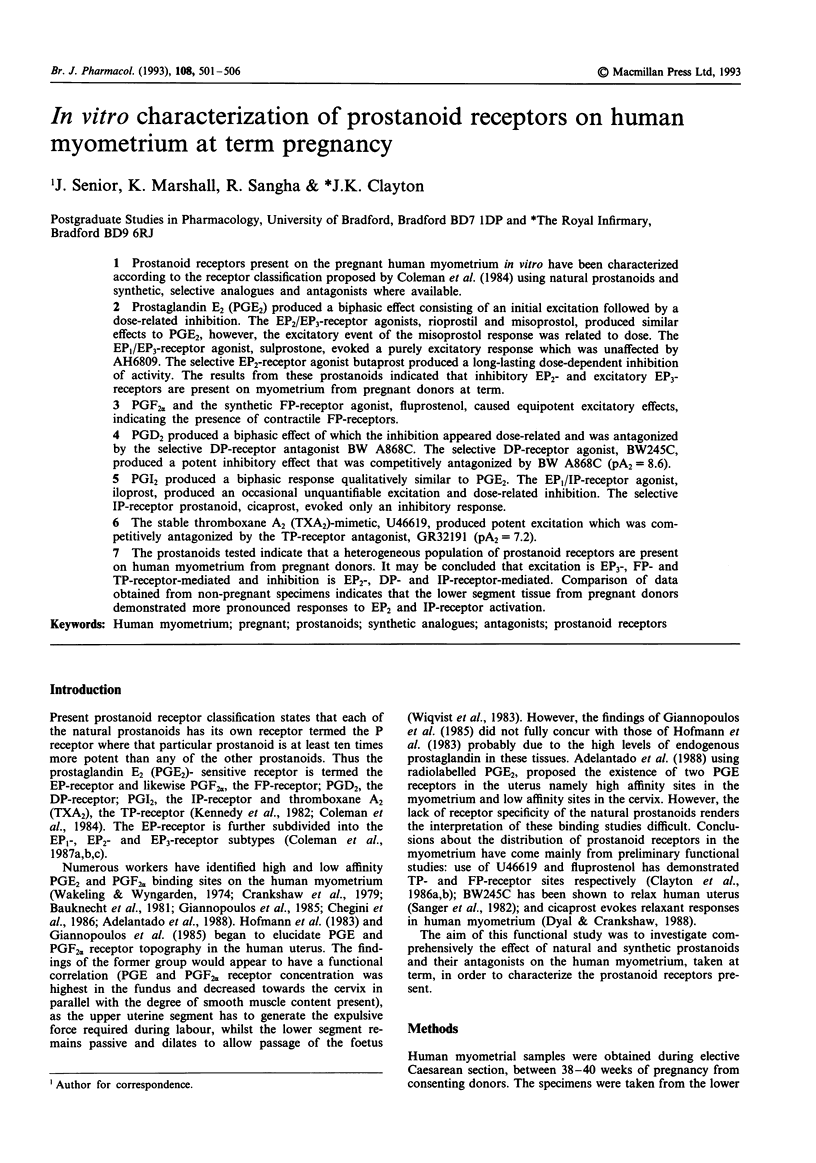
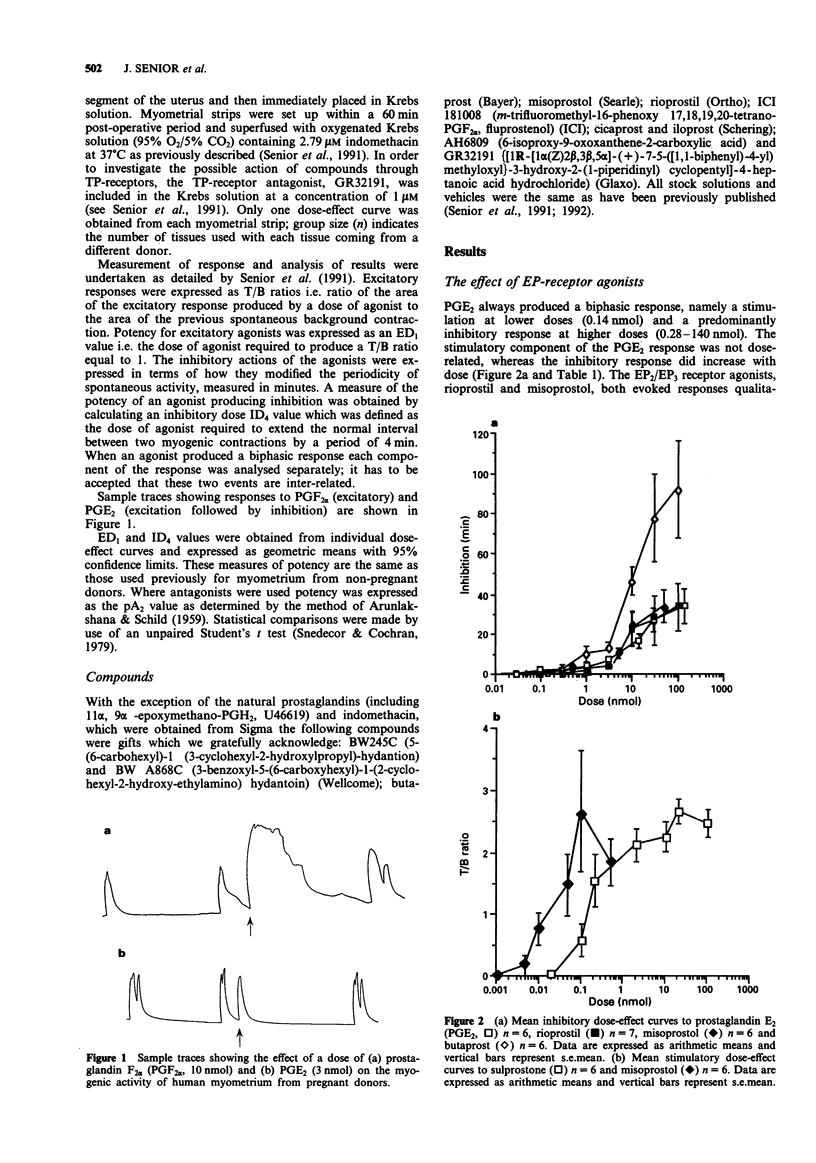
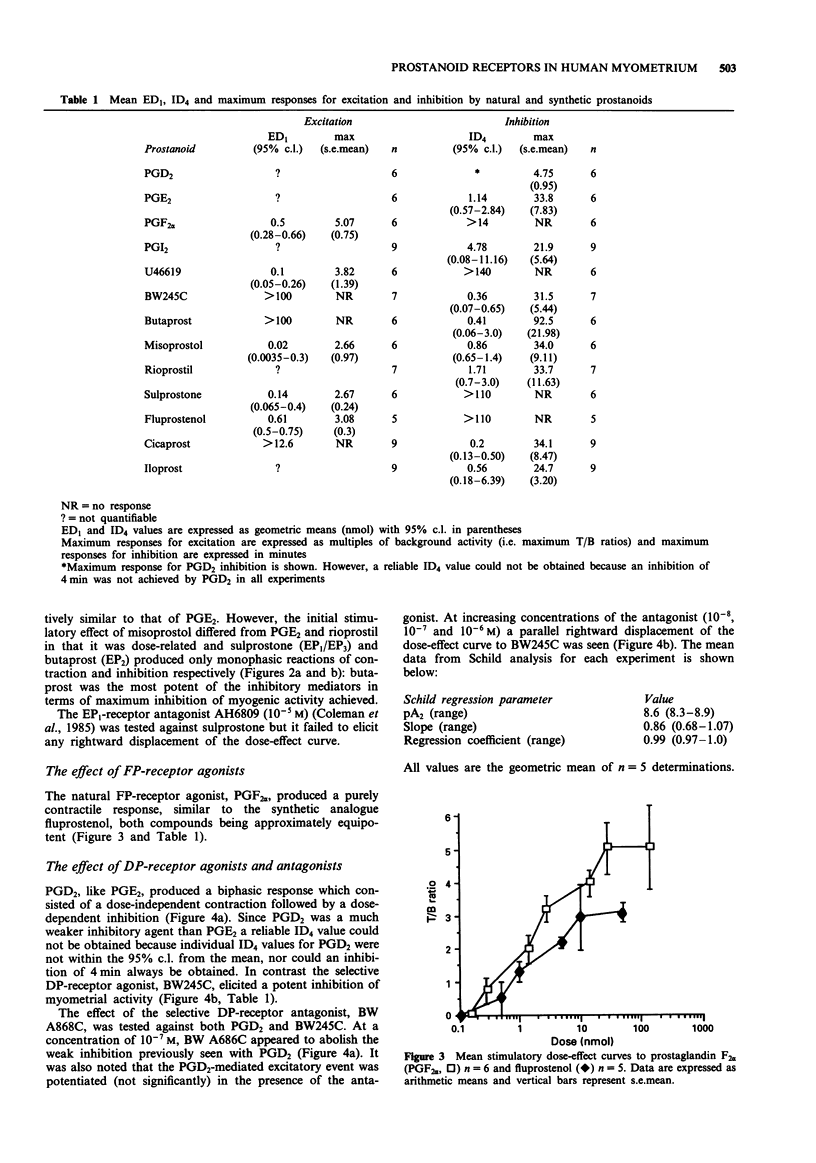
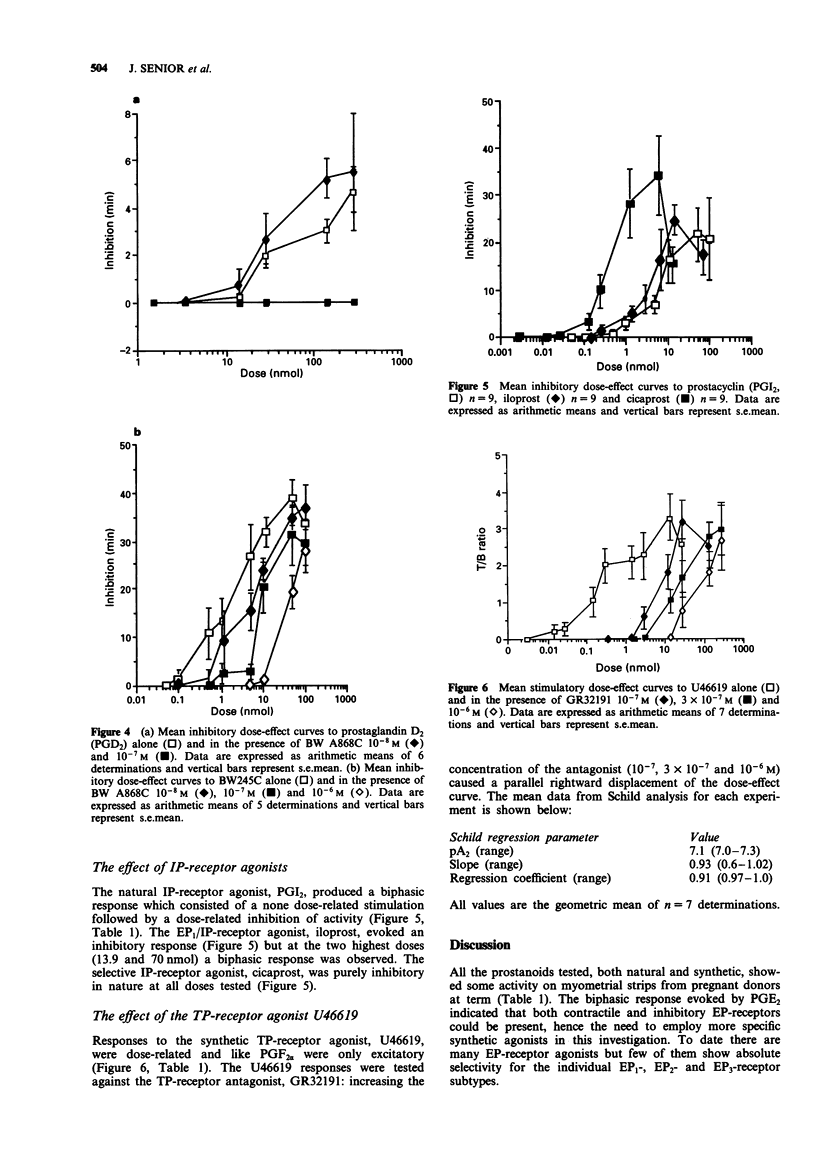
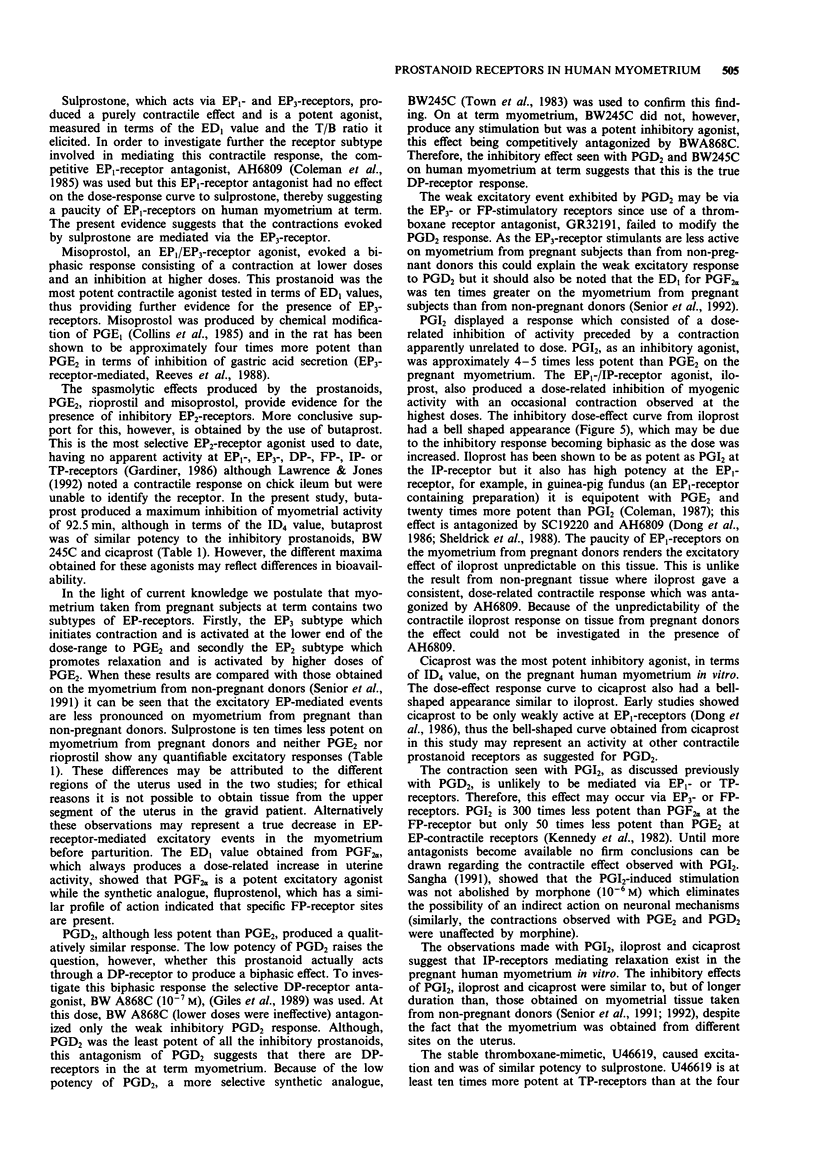
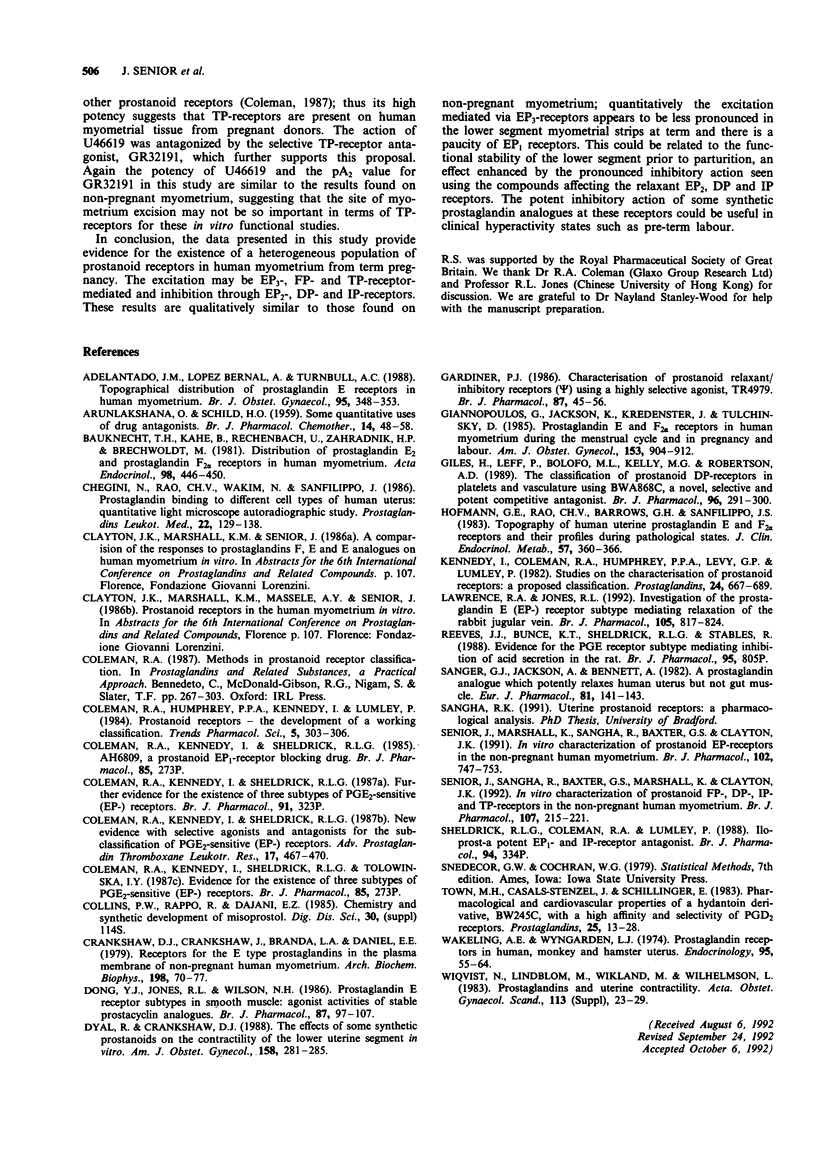
Selected References
These references are in PubMed. This may not be the complete list of references from this article.
- ARUNLAKSHANA O., SCHILD H. O. Some quantitative uses of drug antagonists. Br J Pharmacol Chemother. 1959 Mar;14(1):48–58. doi: 10.1111/j.1476-5381.1959.tb00928.x. [DOI] [PMC free article] [PubMed] [Google Scholar]
- Adelantado J. M., López Bernal A., Turnbull A. C. Topographical distribution of prostaglandin E receptors in human myometrium. Br J Obstet Gynaecol. 1988 Apr;95(4):348–353. doi: 10.1111/j.1471-0528.1988.tb06604.x. [DOI] [PubMed] [Google Scholar]
- Bauknecht T., Krahe B., Rechenbach U., Zahradnik H. P., Breckwoldt M. Distribution of prostaglandin E2 and prostaglandin F2 alpha receptors in human myometrium. Acta Endocrinol (Copenh) 1981 Nov;98(3):446–450. doi: 10.1530/acta.0.0980446. [DOI] [PubMed] [Google Scholar]
- Chegini N., Rao C. V., Wakim N., Sanfilippo J. Prostaglandin binding to different cell types of human uterus: quantitative light microscope autoradiographic study. Prostaglandins Leukot Med. 1986 Apr;22(1):129–138. doi: 10.1016/0262-1746(86)90029-6. [DOI] [PubMed] [Google Scholar]
- Collins P. W., Pappo R., Dajani E. Z. Chemistry and synthetic development of misoprostol. Dig Dis Sci. 1985 Nov;30(11 Suppl):114S–117S. doi: 10.1007/BF01309395. [DOI] [PubMed] [Google Scholar]
- Crankshaw D. J., Crankshaw J., Branda L. A., Daniel E. E. Receptors for E type prostaglandins in the plasma membrane of nonpregnant human myometrium. Arch Biochem Biophys. 1979 Nov;198(1):70–77. doi: 10.1016/0003-9861(79)90396-5. [DOI] [PubMed] [Google Scholar]
- Dong Y. J., Jones R. L., Wilson N. H. Prostaglandin E receptor subtypes in smooth muscle: agonist activities of stable prostacyclin analogues. Br J Pharmacol. 1986 Jan;87(1):97–107. doi: 10.1111/j.1476-5381.1986.tb10161.x. [DOI] [PMC free article] [PubMed] [Google Scholar]
- Dyal R., Crankshaw D. J. The effects of some synthetic prostanoids on the contractility of the human lower uterine segment in vitro. Am J Obstet Gynecol. 1988 Feb;158(2):281–285. doi: 10.1016/0002-9378(88)90138-x. [DOI] [PubMed] [Google Scholar]
- Gardiner P. J. Characterization of prostanoid relaxant/inhibitory receptors (psi) using a highly selective agonist, TR4979. Br J Pharmacol. 1986 Jan;87(1):45–56. doi: 10.1111/j.1476-5381.1986.tb10155.x. [DOI] [PMC free article] [PubMed] [Google Scholar]
- Giannopoulos G., Jackson K., Kredentser J., Tulchinsky D. Prostaglandin E and F2 alpha receptors in human myometrium during the menstrual cycle and in pregnancy and labor. Am J Obstet Gynecol. 1985 Dec 15;153(8):904–910. doi: 10.1016/0002-9378(85)90704-5. [DOI] [PubMed] [Google Scholar]
- Giles H., Leff P., Bolofo M. L., Kelly M. G., Robertson A. D. The classification of prostaglandin DP-receptors in platelets and vasculature using BW A868C, a novel, selective and potent competitive antagonist. Br J Pharmacol. 1989 Feb;96(2):291–300. doi: 10.1111/j.1476-5381.1989.tb11816.x. [DOI] [PMC free article] [PubMed] [Google Scholar]
- Hofmann G. E., Rao C. V., Barrows G. H., Sanfilippo J. S. Topography of human uterine prostaglandin E and F2 alpha receptors and their profiles during pathological states. J Clin Endocrinol Metab. 1983 Aug;57(2):360–366. doi: 10.1210/jcem-57-2-360. [DOI] [PubMed] [Google Scholar]
- Kennedy I., Coleman R. A., Humphrey P. P., Levy G. P., Lumley P. Studies on the characterisation of prostanoid receptors: a proposed classification. Prostaglandins. 1982 Nov;24(5):667–689. doi: 10.1016/0090-6980(82)90036-3. [DOI] [PubMed] [Google Scholar]
- Lawrence R. A., Jones R. L. Investigation of the prostaglandin E (EP-) receptor subtype mediating relaxation of the rabbit jugular vein. Br J Pharmacol. 1992 Apr;105(4):817–824. doi: 10.1111/j.1476-5381.1992.tb09063.x. [DOI] [PMC free article] [PubMed] [Google Scholar]
- Sanger G. J., Jackson A., Bennett A. A prostaglandin analogue which potently relaxes human uterus but not gut muscle. Eur J Pharmacol. 1982 Jun 16;81(1):141–143. doi: 10.1016/0014-2999(82)90613-6. [DOI] [PubMed] [Google Scholar]
- Senior J., Marshall K., Sangha R., Baxter G. S., Clayton J. K. In vitro characterization of prostanoid EP-receptors in the non-pregnant human myometrium. Br J Pharmacol. 1991 Mar;102(3):747–753. doi: 10.1111/j.1476-5381.1991.tb12244.x. [DOI] [PMC free article] [PubMed] [Google Scholar]
- Senior J., Sangha R., Baxter G. S., Marshall K., Clayton J. K. In vitro characterization of prostanoid FP-, DP-, IP- and TP-receptors on the non-pregnant human myometrium. Br J Pharmacol. 1992 Sep;107(1):215–221. doi: 10.1111/j.1476-5381.1992.tb14489.x. [DOI] [PMC free article] [PubMed] [Google Scholar]
- Town M. H., Casals-Stenzel J., Schillinger E. Pharmacological and cardiovascular properties of a hydantoin derivative, BW 245 C, with high affinity and selectivity for PGD2 receptors. Prostaglandins. 1983 Jan;25(1):13–28. doi: 10.1016/0090-6980(83)90131-4. [DOI] [PubMed] [Google Scholar]
- Wakeling A. E., Wyngarden L. J. Prostaglandin receptors in the human, monkey and hamster uterus. Endocrinology. 1974 Jul;95(1):55–64. doi: 10.1210/endo-95-1-55. [DOI] [PubMed] [Google Scholar]
- Williams T. L., Smith D. A., Burton N. R., Stone T. W. Amino acid pharmacology in neocortical slices: evidence for bimolecular actions from an extension of the Hill and Gaddum-Schild equations. Br J Pharmacol. 1988 Nov;95(3):805–810. doi: 10.1111/j.1476-5381.1988.tb11708.x. [DOI] [PMC free article] [PubMed] [Google Scholar]
- Wiqvist N., Lindblom B., Wikland M., Wilhelmsson L. Prostaglandins and uterine contractility. Acta Obstet Gynecol Scand Suppl. 1983;113:23–29. doi: 10.3109/00016348309155193. [DOI] [PubMed] [Google Scholar]


